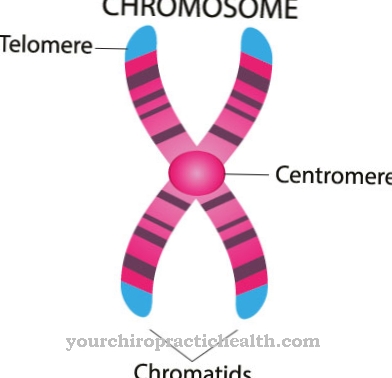The Color blindness belongs to the color vision disorders and can be congenital or acquired. Color vision disorders, sometimes also called color vision disorders, include color vision impairment and the various forms of color blindness. The congenital color blindness remains constant in its course and does not worsen. Acquired color vision impairment may worsen over time without treatment.
What is color blindness?

© Ирина Кузнецова - stock.adobe.com
There are three types of color blindness. In achromatism, there is complete color blindness. Those affected can only see black and white and shades of gray. Partial color blindness, also known as monochromatism, occurs when the person affected can only perceive one color. The dichromacy is also a partial color blindness.
However, those affected confuse two colors with this form. Therefore the dichromasy is divided into three subgroups. Red blindness occurs when the color red cannot be perceived and is therefore confused with the color green.
In the case of green blindness, those affected do not perceive the color green and confuse it with the color red. If there is blue blindness, the color blue cannot be perceived correctly and is therefore confused with the color yellow.
Color blindness is usually congenital and is inherited in a gender-linked manner. The most common form is green blindness. Blue blindness and total color blindness are extremely rare.
causes
Color blindness can be both congenital and acquired. In most cases it is a congenital condition. However, there are various diseases of the optic nerve or the retina that can trigger color blindness.
Colors are recognized with the help of very specific sensory cells, the so-called cones. There are three different types of cones on which there are three different color pigments. The L-cones perceive the color red, the M-cones the color green and the S-cones the color blue.
The mixture of these three basic colors creates all visible color tones in the brain. If the perception of one or even all of the cones is disturbed, color blindness occurs.
You can find your medication here
➔ Medicines for visual disturbances and eye complaintsSymptoms, ailments & signs
The term color blindness is mostly used colloquially and actually refers to the inability to distinguish the colors red and green. The person concerned is therefore not generally blind to all colors, but primarily to the two main colors. Other colors are perceived with a gray haze, but can be distinguished from one another.
It is symptomatic that those affected have difficulty distinguishing red from green objects even in childhood. The phenomenon usually occurs in children's drawings in which the child makes a choice of colors that is irritating or creative for the adult. If you ask more carefully, the inability to perceive your eyes will usually become apparent.
The inability to distinguish colors from one another results in certain difficulties in everyday life, which can usually be easily compensated for in other ways. For example, those affected cannot distinguish an unripe strawberry from a ripe strawberry, so they need help with the selection. Color blindness has no influence on the ability to drive in adults, because the traffic light phases can be recorded based on the sequence.
Help is also often necessary when choosing suitable clothing, labeling the colors in the wardrobe or sorting them by color will help. Color blindness has no disease value, does not lead to a further deterioration in vision and is rather an anatomical peculiarity. Most of those affected get along well in everyday life.
Diagnosis & course
Color blindness can be diagnosed using two different methods. The first possibility is to check the color sense with the help of special color tables, the Ishihara tables. Various numbers composed of spots of color are depicted on these boards. The background is also spotted, but in a different color. However, numbers and background have the same brightness.
Patients with color blindness either fail to recognize the numbers or recognize them incorrectly. By evaluating the results on the various boards, the doctor can determine which form of color blindness is present. The so-called anomaloscope is available as a second possibility for diagnosis. This is a type of tube through which the patient looks at a two-part test disc.
In the lower part of the pane, a certain shade of yellow is shown, the brightness of which can be changed. In the upper area of the test disc, the patient must imitate the yellow shade shown by mixing red and green. Based on the patient's mixing result, the doctor can diagnose a certain form of color blindness. All congenital forms of color blindness remain constant in their course.
With color blindness, symptoms vary in severity depending on the cause. The visual impairment occurs most frequently in the red-green area. Unfortunately, there is no effective therapy for congenital color blindness. In the acquired forms, other diseases are causally responsible for the visual impairment. Usually these are diseases of the optic nerve or the retina.
Depending on the underlying disease, other visual functions can also be restricted.
Complications
There are many different complications associated with color blindness. As a rule, the patient can lead a normal life even with color blindness and is only barely affected in his way of working and his activities. However, there is no known cure for congenital color blindness.
In this case, the patient must live with the symptom for life. Complications can primarily be psychological in nature and lead to decreased self-esteem. In some cases it is not possible for the person concerned to work in certain professions or to actively participate in road traffic.
The risk of an accident is also slightly higher due to color blindness. However, if there are no accidents or other injuries, life expectancy is not reduced due to color blindness. Color blindness makes some everyday activities more difficult, but they can be mastered with exercises.
If color blindness occurs in the course of an illness, it can in some cases be improved or completely cured. However, the underlying disease is always treated first. Color blindness itself does not lead to any particular medical complications.
When should you go to the doctor?
In general, color blindness does not require a visit to a doctor. The symptoms of color blindness do not worsen over time and, unfortunately, cannot be treated. However, if the disease is not congenital but acquired, a visit to the doctor can be worthwhile in order to avoid further complications.
The doctor must be consulted if the symptoms increase or if the patient's eyesight develops negatively in addition to the color blindness. This can lead to various complaints, such as blurred vision or double vision.
The examination and treatment of color blindness is usually carried out by an ophthalmologist. In some cases, diagnosing the underlying condition can also completely cure color blindness. However, these cases only occur very rarely.
If you have a visual impairment, you must always wear a visual aid so as not to further promote this visual impairment. Especially with children, parents need to make sure that they wear glasses correctly. As a rule, this disease does not negatively affect the patient's quality of life and does not reduce it.
Doctors & therapists in your area
Treatment & Therapy
If the color blindness or color vision disorder is congenital, there is still no treatment method to cure it.
If the cause is another condition, measures to treat those conditions can be taken. In some cases it is also possible to reduce or even cure color blindness.
Outlook & forecast
The prognosis of color blindness is linked to the extent of the existing impairments and the cause of the disease. With a congenital disorder of the eyesight, no change in color blindness can be achieved despite modern medical therapies. The missing visual cells that enable color vision were not created in the embryo's development process for genetic reasons.
If color blindness is acquired in the course of life, further deterioration in visual acuity may develop. This is especially true for those affected who do not seek medical care. Depending on the extent of the impairment, the wearing of special glasses, the use of magnifying glasses or binoculars can lead to an improvement in eyesight.
With optimal light influences and the presence of two-color vision, the symptoms can be alleviated. In individual cases, patients with a neurological cause of color blindness have the prospect of a cure.
If the doctors succeed in finding the reason for the impairment in extensive examinations, there is a chance of recovery. If the cause can be treated or removed by surgery, the patient has a good prognosis. After a few months of therapy, normal vision may return. Spontaneous healing can also occur in patients suffering from trauma or shock.
You can find your medication here
➔ Medicines for visual disturbances and eye complaintsprevention
Since color blindness is a congenital condition in the majority of cases, it is not possible to take preventive measures against the occurrence of the disease. The disease can be inherited depending on the sex. Men are affected more frequently than women. It therefore makes sense to have an early diagnosis made if there is a hereditary predisposition for the occurrence of color blindness.
Aftercare
With color blindness, the options for follow-up care are extremely limited. As a rule, this disease cannot be treated either, so that those affected have to live with this complaint for their entire life. Only in very rare cases can color blindness be treated or improved.
Self-healing does not occur with this disease, although color blindness does not reduce the life expectancy of the person affected. The earlier the disease is detected, the better the further course of this complaint. As a result of this disease, those affected are mostly dependent on the help of other people in their lives so that they are not too restricted in everyday life.
Above all, the loving and caring support from one's own family or friends has a very positive effect on the course of the disease. In this way, depression or other possible psychological upsets can be avoided, which can have a negative effect on the quality of life of the person concerned.
Contact with other color blind patients can also be useful. This often leads to an exchange of information, which can make everyday life much easier. If color blindness is congenital, genetic counseling is sometimes useful if you wish to have children.
You can do that yourself
In the retina of the eyes, in the area of sharpest vision, the macula, there are three different cone-shaped photoreceptors, each of which is particularly sensitive to blue, green and red light.
In the rest of the retina there are mainly rod-shaped photoreceptors that perceive extremely weak light and are extremely sensitive to moving objects in the periphery. The more common color weakness must be distinguished from true color blindness, in which one or more types of cones for color vision fail completely due to genetic makeup or other factors.
A color weakness is present if, for example, the cones for red or for green have reduced visual performance. There are (yet) no effective therapies for congenital color blindness. Congenital color blindness no longer changes throughout life.
If it is an acquired color blindness, the course depends on the causative factors. If these can be eliminated, no further deterioration in vision is to be expected, but neither is there any serious improvement, because failed photoreceptors cannot regenerate.
Training courses that convey how statements can be interpreted from secondary lighting information can be considered as self-help measures. For example, the red that lights up at the traffic light is always the top light, while the bottom light is always on when the light is green. If the normal lighting suddenly lights up brighter at the rear of a car, it is the brake light.
























.jpg)



